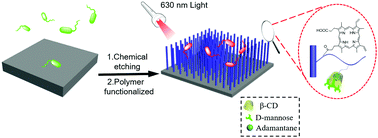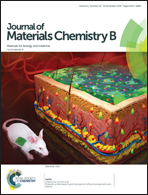A highly efficient bactericidal surface based on the co-capture function and photodynamic sterilization†
Abstract
Bacterial infection is posing a great threat to human life, and constructing a platform to capture or kill the bacteria attached on a material surface is of particular significance. Herein, a nano-topographic material surface (SiNW-p-ppix@CDm) has been successfully synthesized based on silicon nanowire (SiNW) arrays modified with a random copolymer, which was decorated with photosensitive protoporphyrin IX (ppix) and β-CD-mannose7 (CDm). The as-prepared surface exhibits a highly efficient bacterial capture, which is based on the co-capture function between the SiNW topographic surface and the bacterial attachment molecule CDm, and sterilization of ppix under irradiation by 630 nm light. The Gram-negative bacterium Escherichia coli (E. coli) was adopted to evaluate the surface bactericidal efficiency. Finally, the killing efficiency can be proved to be 96.7% from fluorescence microscopy after staining with the live/dead bacterial viability kit. The reason for sterilization is that the bacterial cell wall had been split by the reactive oxygen species (ROS), which could be demonstrated via scanning electronic microscopy (SEM). This functional substrate could be used for bacterial enrichment apparatus such as used in water quality monitoring, and even in constructing clinical antibacterial materials.



 Please wait while we load your content...
Please wait while we load your content...